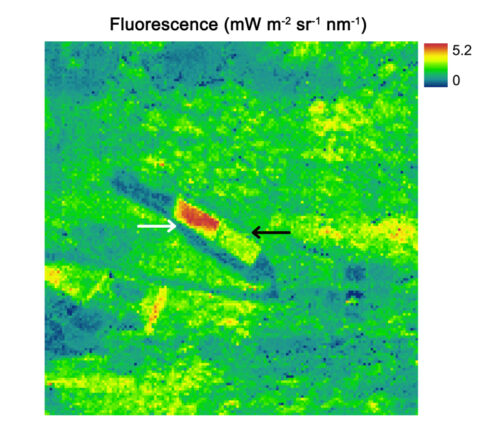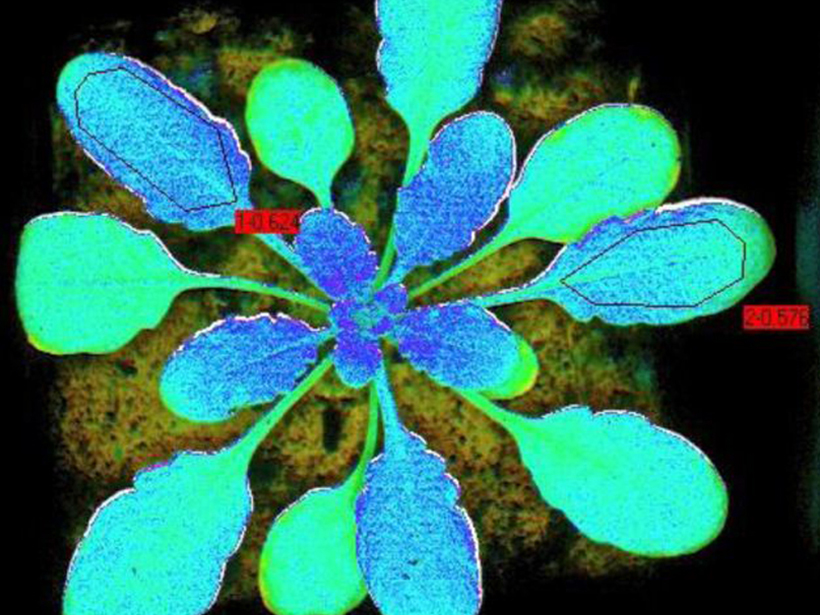Source: Geophysical Research Letters
Photosynthesis—the process by which plants use sunlight to convert carbon dioxide and water into carbohydrates—is the basis of nearly all energy available for life on Earth. Understanding how plants regulate short-term changes in photosynthesis in response to varying environmental conditions is important for improving plant production and for coping with climate change.
When photosynthesis efficiency falters, a portion of the sunlight not absorbed by a plant will be emitted in the form of chlorophyll fluorescence. In a new study, Rossini et al. used a new airborne imaging spectrometer to map this fluorescence signal.
Plants generally use the majority of the light they absorb for photosynthesis; only a small part is emitted as chlorophyll fluorescence or as heat. However, under suboptimal growing conditions, plants reduce their photosynthetic efficiency. Because the fate of any light striking a plant will be involved in either photosynthesis, fluorescence, or heat dissipation, any variation in the efficiency of one process affects the efficiencies of the others.
Under this logic, the researchers reasoned they could infer photosynthetic efficiency by measuring the chlorophyll fluorescence emission. To measure the chlorophyll fluorescence, the team studied vegetation treated with an herbicide that interrupts electron transport during photosynthesis and also inhibits heat dissipation.
Whereas previous studies have reported the use of tower platforms to accurately measure chlorophyll fluorescence in the far-red spectral region, it has been more difficult to measure the red signal because of the insufficient resolution of available sensors. To overcome this limitation, Rossini and her team employed a spectrometer that will be launched on the European Space Agency’s Fluorescence Explorer (FLEX) satellite mission. The heart of this spectrometer is the Hyplant sensor—the only currently available aerial sensor with a subnanometer spectral resolution in the red to far-red spectral region.

From an airborne platform, the researchers used Hyplant and measured a significant increase of both red and far-red fluorescence on a grass field that had been sprayed with the herbicide. Fluorescence increased at higher herbicide concentrations, whereas no changes in fluorescence were observed on an untreated control field.
These observations prove the feasibility of estimating chlorophyll fluorescence in the far-red and, for the first time, the red spectral regions from an airborne platform and demonstrate that both of these signals can be used to infer changes in the photosynthesis efficiency.
The herbicide applied in this study induces an increase of fluorescence emission because it blocks the two pathways occurring in competition with fluorescence: photosynthesis and nonradiative dissipation as heat. In contrast, other stressors tend to induce a reduction of photosynthetic efficiency but typically increase nonradiative dissipation, which generally results in a decline in fluorescence emission. Thus, the authors note that the pathway by which factors influence photosynthesis is important to understand. (Geophysical Research Letters, doi:10.1002/2014GL062943, 2015)
—Chris Palmer, Freelance Writer
Citation: Palmer, C. (2015), Airborne sensor can track photosynthesis efficiency, Eos, 96, doi:10.1029/2015EO033955. Published on 7 August 2015.
Text © 2015. The authors. CC BY-NC 3.0
Except where otherwise noted, images are subject to copyright. Any reuse without express permission from the copyright owner is prohibited.

